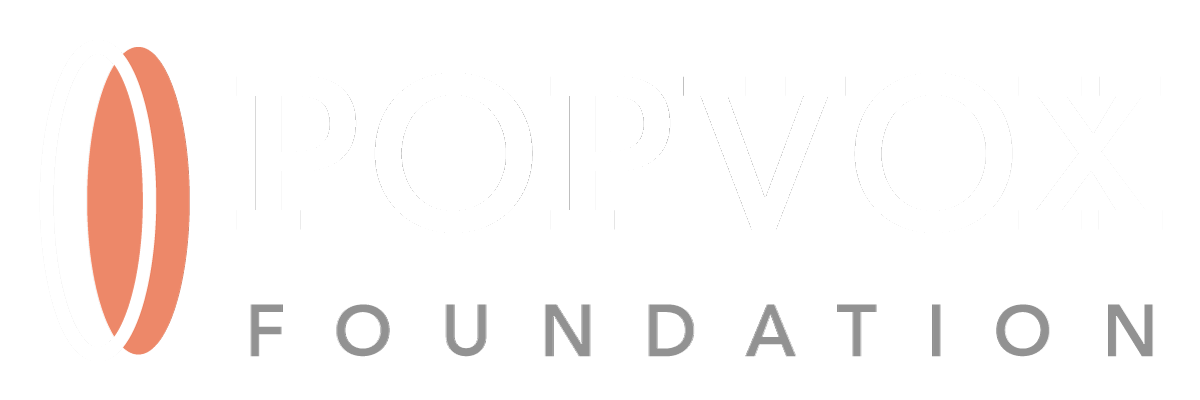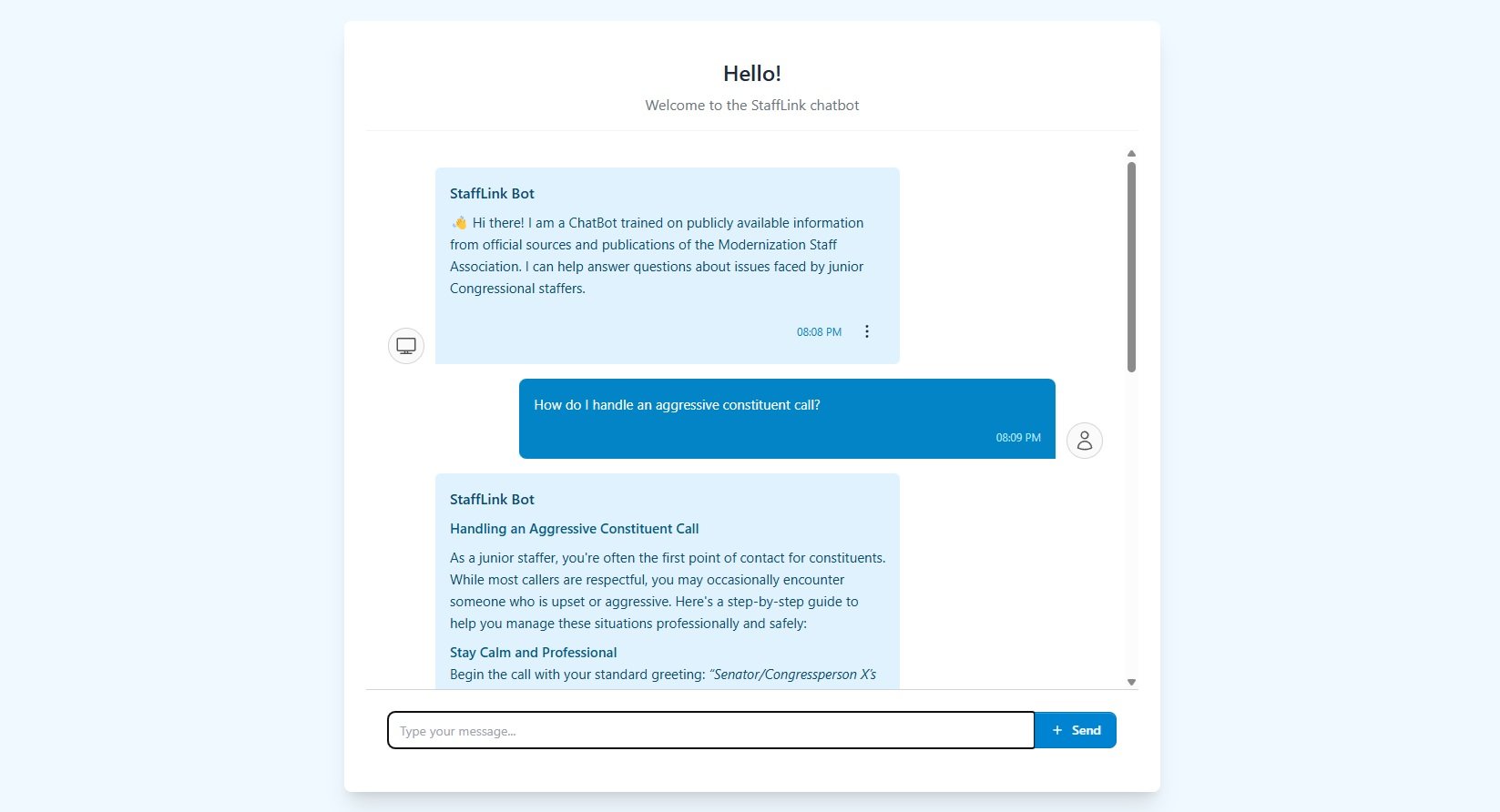Beta Takeaways: Key Lessons on StaffLinkBot.org
BY AUBREY WILSON
Innovation is a key pillar of our work at POPVOX Foundation and, as a team of prior Congressional staffers, our passion is supporting legislative institutions as they adapt to a rapidly changing world. To this end, we believe nonprofit organizations can play an impactful role in helping those in and adjacent to government understand and deploy emerging technologies to do their jobs better. We thrive in this space and, with the emergence of Generative AI, have been on the forefront of experimenting and beta testing how this technology can be used responsibly in a legislative setting to boost capacity, foster trust and transparency, and save taxpayer dollars.
To kick off 2025 and the start of the 119th Congress, we undertook the creation of an AI-powered chatbot designed with newly hired Hill staff and interns in mind, but publicly available to also be of benefit to those in academia, international legislatures, etc.
As we continue to showcase new approaches to technology and beta test use cases with the intended audiences, we want to be transparent and collaborative by providing updates to our stakeholders and community. This is the first in a series of progress reports for our staff chatbot: StaffLink.
StaffLinkBot.org remains in beta, and this post captures our first-week observations and next steps.
Setting the Stage
We launched StaffLink on April 28 as a narrow-scope, open-source chatbot that can aid junior Congressional staffers as well as benefit the public’s understanding of how Congress works. Its knowledge base draws exclusively on publicly available resources (Modernization Staff Association guides, House and Senate guidance, CAO materials).
The StaffLink beta test is currently live at stafflinkbot.org.
Boundary-Driven Design Is Essential
What happened
The tool has been successful on its intended use – assisting with finding institutional or position-specific information related to common daily workflows for junior staff. However, some testers asked StaffLink questions outside its intended remit. For example, we observed users asking specific questions regarding how to update their Member’s official website or to define niche policy acronyms. In some cases the bot “hallucinated” or returned outdated or incorrect details to these inquiries.
Our response
We implemented an override system that recognizes known out-of-scope patterns and routes them to a safe “scope-limited” refusal with guidance on where to look. This is an attempt to ensure StaffLink will not guess when it lacks authority. We’ll keep testing the bot to verify this behavior.
Proactive Compliance & Transparency
What happened
Questions arose regarding the tool’s validity and appropriateness as a resource for Congressional staff. Since all resources that the bot is trained on are already available to staff through other channels, we received critical feedback that a chatbot repackaging this information is potentially confusing or redundant.
Our response
Transparency: Regarding the validity of the information StaffLink provides, we have documented every source used on our “Resources” page, our technical approach and process on the “About” page, and we have open-sourced our code at GitHub.
Compliance: In addressing concerns of appropriateness, we have been diligent in our attempts to be as proactive and compliance-oriented as publicly available Congressional guidance allows. While the House and Senate have not made their policies for third party applications public, we have been responsive to any inquiries and attempted to anticipate any potential issues. This includes:
Speech or Debate: We confirmed with House CAO legal counsel that we do not collect identifiable user data and if we ever received a subpoena for records, would treat all queries as subject to speech or debate protections.
Gift Rule: The app was created independently and released to the public. So, while the subject matter is related to the Congressional ecosystem, it is a tool that can be used by anyone, therefore, not a “gift” to Congress.
Cybersecurity: We have been informed that a cybersecurity review of the tool is being undertaken by the House but have not received any notice or requests for information from either the House or Senate*. Neither chamber has a publicly available policy with information about the practices third party apps should adhere to in order to be approved for use, so we have done our best to deploy responsibly. We are committed to making any changes or adjustments necessary in a timely manner if we receive any input from either chamber that would be helpful.
Why it Matters: Third-Party Beta Tests Accelerate Learning
We are sharing the details about this process because so little is available publicly and we hope our experience can be helpful to other third party organizations that are working to help increase Congressional capacity through innovation.
As an independent nonprofit passionate about boosting Congressional capacity, we have the capability and drive to roll out “beta” solutions, tolerate early glitches, and iterate rapidly. Our findings offer real-world insight into where institutional AI tools may struggle and excel.
Benefits observed
Low-risk experimentation: Congress pays nothing to learn from our pilot.
Community feedback loop: Early adopters flag issues we could not anticipate in development.
Shared learning: Other legislatures — statehouses and parliaments abroad — can apply these lessons without reinventing the wheel.
Kick the Tires
Whether you’re a prior Congressional staffer, legislative nerd, civil society advocate, or simply an interested party, we welcome your feedback on StaffLinkBot.org. If you spot a misstep in procedure, run into a scope boundary, or want to discuss our process, let us know. Our mission is to help democratic institutions keep pace with a rapidly changing world. Your real-world use cases drive our next iterations.
Visit StaffLinkBot.org to try the beta.
*Note: At this time, StaffLink is not approved for internal use by the House or Senate.

